#chiricahua leopard frog
Photo
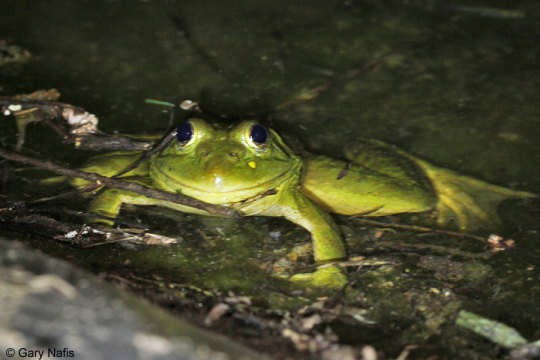

These funny guys are Chiricahua leopard frogs [Lithobates chiricahuensis, synonymous with Rana chiricahuensis], a species native to Mexico as well as parts of the US. They are severely threatened by habitat loss, having lost an estimated 80% of their previous range due to human activity. Captive breeding efforts are currently underway at the Phoenix Zoo; you can donate to the zoo here. Images by Californiaherps.com.
147 notes
·
View notes
Text

Chiricahua Leopard Frog (Lithobates chiricahuensis), family Ranidae, Miller Canyon, Sierra Vista, Arizona, USA
This species has been eliminated from 80% of its native range. It is considered threatened due to habitat loss, introduced species, and the chytrid fungus.
photograph by Joseph Morlan
91 notes
·
View notes
Text
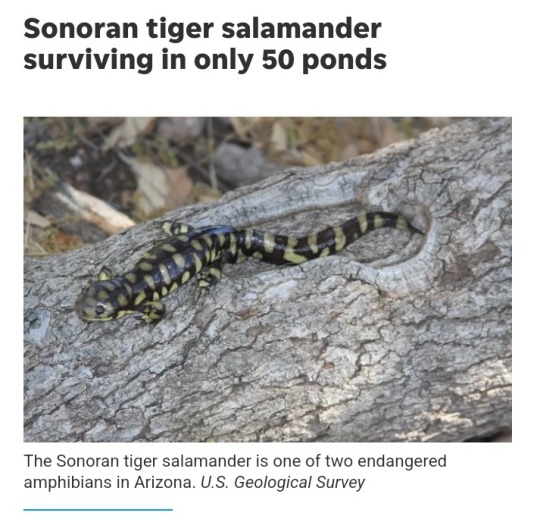
First added to the endangered species list in 1997, this salamander can only be found in a small region of Southern Arizona and New Mexico. Their most important habitat requirement is year-round availability of standing bodies of water for breeding, growth and development. Permanent bodies of water can also provide good habitat for invasive fish and bullfrogs that prey on the salamanders' eggs and larva. [...] They are believed to be found in about 50 ponds in Cochise and Santa Cruz counties. [...]

Once found in more than 400 aquatic sites in the Southwest, the Chiricahua leopard frog is now found at fewer than 80. The frogs need permanent water for reproduction which is increasingly difficult to come by due to drought, groundwater pumping, diversion and livestock grazing. [...]
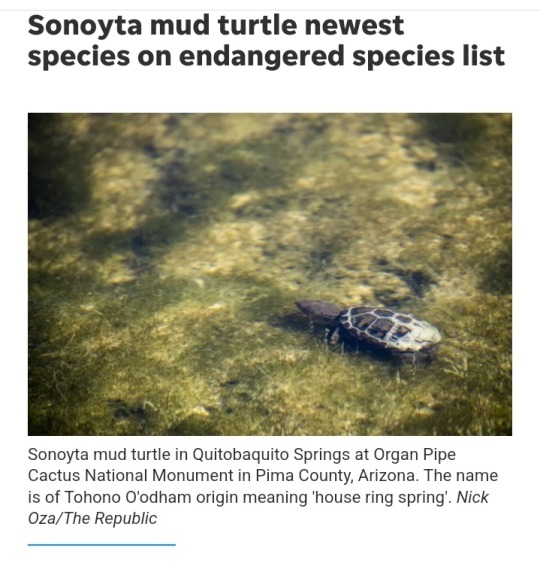
The Sonoyta mud turtle evolved as an aquatic species in one of the driest parts of the Sonoran Desert. They are the state’s newest inductee to the endangered species list and the turtles were granted critical habitat protection in 2020. [...]

---
Headline, images, captions, and all text as published by: Jake Frederico of Arizona Republic. “Jaguars, leopard frogs, condors: Here are some of Arizona’s most imperiled species.” As published online at AZ Central. 3 March 2023.
41 notes
·
View notes
Video
youtube
Seven+ minute video about the Gila River, a wild, free-flowing river running from New Mexico through Arizona to the Gulf of California. Description of this video from the Center for Biological Diversity:
Flowing out of the United States’ first federally protected wilderness area, the Gila River is now the Southwest’s last major free-flowing waterway. Between its source in New Mexico’s Gila Wilderness and its mouth in the Gulf of California, it weaves a ribbon of green through Arizona’s arid Sonoran Desert, harboring endangered species like Chiricahua leopard frogs, Gila chubs and yellow-billed cuckoos. Watch this video to see breathtaking footage and hear interviews with Gila experts, including Center cofounder Todd Schulke. You’ll learn about efforts to protect the river from dams and diversions and the current fight to keep the Gila forever free through a Wild and Scenic River designation.
16 notes
·
View notes
Photo

Chiricahua leopard frog (Rana chiricahuensis) at Ramsey Canyon.
The Nature Conservancy has created artificial habitat at Ramsey as part of an effort to restore frog populations in the Madrean sky islands. The species requires permanent water sources, and is threatened throughout its range due to habitat loss, especially where water has been diverted for livestock use or degraded by grazing cattle.
#photographers on tumblr#Chiricahua leopard frog#frog#Rana chiricahuensis#Ramsey Canyon Preserve#The Nature Conservancy#Cochise County#Arizona
161 notes
·
View notes
Text

today’s funky frog of the day is: lithobates chiricahuensis! commonly known as the chiricahua leopard frog, they are native to mexico and the united states. they inhabit a wide variety of places, including forests, rivers, swamps, lakes, marshes, springs, and ponds. unfortunately, they are threatened by habitat loss as well as a chytrid fungus that has eleminated 80% of their natural habitat. however, efforts are being made to save these frogs. they are large and stocky, and they range from dark green to brown in color. they typically breed and call near water, and eggs are laid in submerged vegetation. they are expected to live 6 years at most, and they have been seen to eat small insects such as crickets.
168 notes
·
View notes
Photo








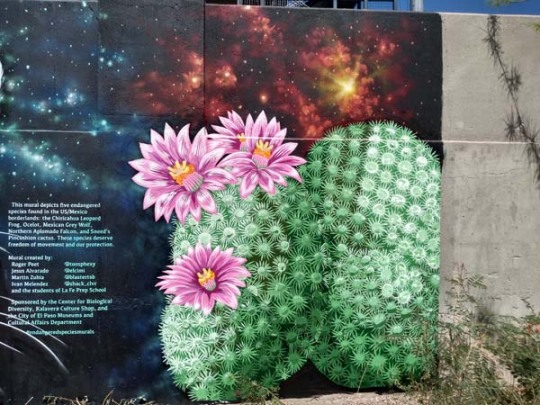
The sixteenth of the Endangered Species Murals is finished! This big wall is located near the Convention Center in downtown El Paso, Texas, and features five endangered species from the US/Mexico borderlands: the Chiricahua Leopard Frog, Northern Aplomado Falcon, Mexican Grey Wolf, Ocelot, and Sneed’s Pincushion Cactus. The mural was created by me and three other artists: Jesus “Cimi” Alvarado and Martin “Blast” Zubia from El Paso, and Ivan “Shack” Melendez from Ciudad Juarez. We also worked with the students of La Fe Prep school in El Paso’s Segundo Barrio neighborhood on the cactus. We employed a technique that was new to me- painting on a polyester substrate called Polytab, which is then adhered to the wall with a gel medium. This made it possible to work on the heads indoors at a downtown studio, and to bring the panels into the school to work with the youth.
It was a real pleasure to work with these artists and students to create this international collaboration, and I think it does a pretty good job of summarizing one big truth about the border- that these lands are intrinsically connected, that there’s nothing that separates them, and that the communities of humans, animals and plants that inhabit them deserve freedom of movement and protection from harm. You can read some great press on the project here, here, and here. This was sponsored by the Center for Biological Diversity (see all the murals in the series here) and the City of El Paso Museums and Cultural Affairs Department as well as Kalavera Culture Shop. Follow the artists on social media as @elcimi, @blastertsb, @shack_clvr, and @toosphexy.
#mural#project#el paso#texas#murals#street art#borderlands#ocelot#aplomado falcon#chiricahua leopard frog#sneeds pincushion cactus#mexican grey wolf#polytab#roger peet#el cimi#kalavera culture shop
2 notes
·
View notes
Photo

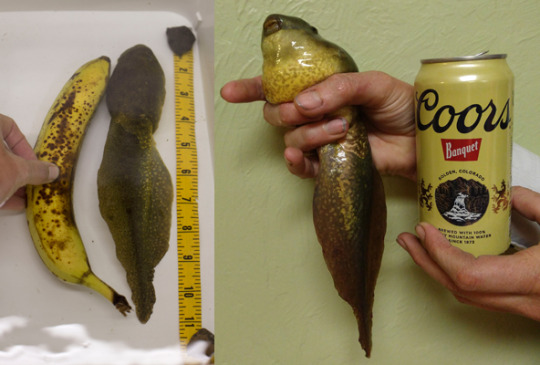
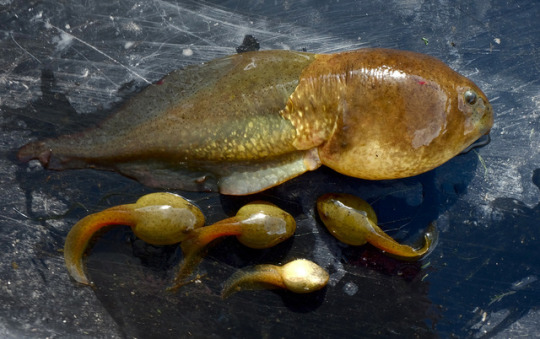
The Giant Tadpole That Never Got Its Legs
By Katie L. Burke
A record-breaking, 10-inch-long whopper of a bullfrog tadpole was discovered by a crew of ecologists in a pond in Arizona.
The biggest tadpole ever found—at a whopping 10 inches long—was discovered by a crew of ecologists in a pond in the Chiricahua Mountains of Arizona. Alina Downer, an intern at the American Museum of Natural History's Southwestern Research Station, came across the monster bullfrog tadpole as her crew was draining a manmade pond as part of a habitat restoration project for the endangered Chiricahua leopard frog.
As the water level lowered, Downer and her colleagues were assessing what organisms were left in the muddy shallows that she likened to “chocolate soup.” Downer says, “I was fishing around with my hands while walking in the water, and I felt something large, smooth, and wriggly—which was unexpected, since the only other fish in the pond were about an inch long.”
As an avid naturalist, Downer’s first instinct was curiosity. “At first I thought it was a giant catfish,” she says, grinning at the uncanny memory. “Whatever it was, I knew I had to grab it.” She herded the slippery creature into shallower water until she could capture it. To her surprise, it turned out to be “an enormous monster of a tadpole”—so big she had to hold it with two hands...
Read more: American Scientist
#frog#ranidae#amphibian#herpetology#animals#nature#developmental biology#science#biology#non-native invasive#north america#arizona
29K notes
·
View notes
Text
WHAT CAN TRAVELERS LEARN FROM ANCIENT FARMERS?
— Friday, July 16, 2021
By George Stone, TRAVEL Executive Editor

“People Belong to the Landscape, and Not the Other Way Around.”
That’s Angela Garcia-Lewis, of the Salt River Pima-Maricopa Indian Community, speaking about the relationship her ancestors have held with the environment for generations.
It’s not just a platitude. In Arizona, Garcia-Lewis’s community, along with the rest of the Phoenix metropolis, depends on the Salt River for water, electricity, recreation, and the preservation of habitats for endangered birds and reptiles like the western yellow-billed cuckoo and the Chiricahua leopard frog.
It’s nothing new. By 1450 A.D., the culture that archaeologists call Hohokam had created the largest expanse of irrigated land north of Peru along Arizona’s Salt and Gila rivers, reports Rebecca Toy. But volatile conditions add pressure to the river and the region it has supported since the Huhugam first harnessed it as early as 600 A.D.
“As climate change, drought, and record heat raise anxiety across arid landscapes, the future of the Salt River and Phoenix are bound together,” writes Toy. For this metro area of over 4.5 million people—and for all other population centers—there’s still time to learn valuable lessons about conservation ecology from traditional stewards.
In a new National Geographic and Morning Consult poll of 2,200 American adults taken July 1-3, nearly half say climate change (including an increase in sea levels, extreme weather, and wildfires) has become a bigger threat. For more than a third of Americans, that confluence of events is influencing decisions on where to live.
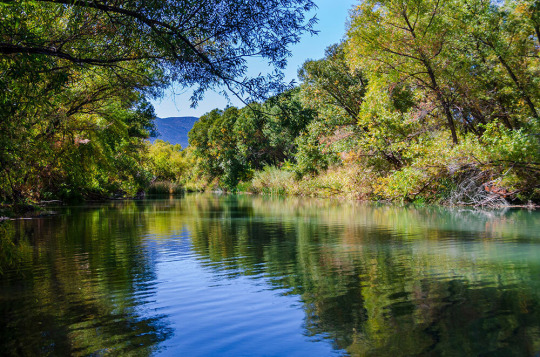
The Salt River offers a time-honored model: “Ancient farmers lived through a wide variety of dramatic and traumatic change. Droughts, floods, political and social change,” says Chris Caseldine, an archaeologist at Arizona State University. “The canals connect people to that past, but the important thing is the descendants of the ancient farmers and irrigators, they’re still here.” (Pictured above, a rare deciduous forest on the Verde River, a tributary of the Salt.)
For travelers aiming to honor the past as they explore, the Salt River courses through eras and ecosystems, sustaining diverse desert wildlife along the way. This ancient waterway asks visitors to own their debt to the landscape—and look for ways to support this unique, and threatened, habitat.
0 notes
Text
Rare '<b>Snoring</b>' Frogs Found in Place They Shouldn't Be
Rare 'Snoring' Frogs Found in Place They Shouldn't Be. Nearly a dozen threatened Chiricahua leopard frogs spotted in central Ariz., not their usual ...
from Google Alert - snore https://ift.tt/3fYmJbB
0 notes
Text

Chiricahua Leopard Frog (Lithobates chiricahuensis), family Ranidae, Coconino National Forest, Arizona, USA
This species has been eliminated from 80% of its native range. It is considered threatened due to habitat loss, introduced species, and the chytrid fungus.
photograph by Jim Rorabaugh/USFWS
56 notes
·
View notes
Text
Cool thing: the precarious existence of amphibians in desert ecoregions. Leopard frogs have some surprising biodiversity in the “true” deserts of North America and the American Southwest, including 3 species entirely endemic to the deserts. (Sorry in advance; amphibian biogeography hyperfixation activated.)
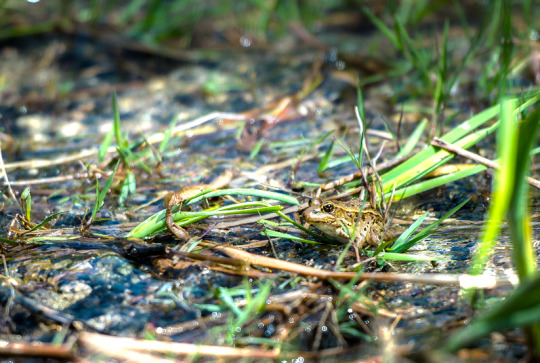
A relict leopard frog, a highly-endangered frog which has a very small distribution range limited only to little wetlands and desert springs near Las Vegas. [Photo by Todd Miller for National Park Service.]
Obviously, chrytid fungus, chemical use in agriculture, development of riparian corridors, and climate change have provoked the widely reported “amphibian apocalypse”; but leopard frogs, especially leopard frogs in the drylands of the American West, have been especially victimized, and there has been severe local extinction, population decline, and habitat loss for leopard frogs living west of the Rockies and in the deserts of the Southwest. Anyway, the presence of these creatures in the desert is interesting to me, because the frogs in the genera Rana/Lithobates are famous to most people living in Europe and North America; they’re the “common” frogs or “pond” frogs or whatever, and they’re usually associated heavily with moisture and water.
There are 3 (formerly 4) distinct species of leopard frog endemic to the true deserts of North America (Mojave, Sonoran, and Chihuahuan desert ecoregions), and they’re all imperiled or endangered in some way, with huge losses in distribution range area in the past few decades. (There are also 2-ish other species of leopard frog living on the periphery of the deserts, though they also live outside of the region and are not endemic.)
1 - Chiricahua leopard frog (Lithobates chiricahuensis)
In the region, the Chircahua leopard frog is sort of, kind of, a little bit like a “Sky Islands species.”

The frog lives in the “temperate sierra” of the Arizona-New Mexico mountain spine, with Mogollon Rim at its northern edge; the frog also lives along the corridor of pine-oak woodlands in the Sky Islands and along the mountains of the Madrean Archipelago. It’s the same ecological corridor of pine-oak habitat associated with distribution range of charismatic animals like ocelots and jaguars. A lot of iconic species, like ridge-nosed rattlesnakes and the now-extinct imperial woodpecker, have distribution ranges completely limited to the Sky Islands and pine-oak corridor.
Here’s a map of the northern Sky Islands populations, at the ecological border between the Sonoran and Chihuahuan deserts, righteously appropriated from US FWS:

And here’s the wider distribution of the species (follows the corridor of pine-oak woodlands along the crest of Sierra Madre Occidental):

A map of recent loss of distribution range, from Reptiles of AZ:
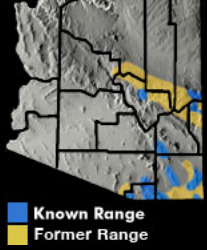
-----
2 - Lowland leopard frog (Lithobates yavapaiensis)

The lowland leopard frog lives along lower slopes of the temperate sierra and along riparian corridors, including the lower Colorado River.

The frog is actually now, apparently, extinct in some of the riparian corridors of the Gila and lower Colorado.
Another distribution map for the species, showing recent habitat loss, from Reptiles of AZ:

-----
3 - Relict leopard frog (Lithobates onca)
And then there’s the critically endangered and aptly-named relict leopard frog, which lives in a very limited range in a narrow corridor between Lake Mohave and St. George (Utah), very close to Las Vegas. The frog’s habitat exists near the ecological border where the Mojave Desert meets the Colorado River and the western edge of southern Utah’s mountains and many canyons, and it probably originally lived along a small portion of the Colorado River corridor that was mostly destroyed with the damming of Lake Mead.
The frog depends on very small springs, where subterranean water occasionally surfaces and creates little patches of wetland vegetation surrounded by desert or arid steppe.
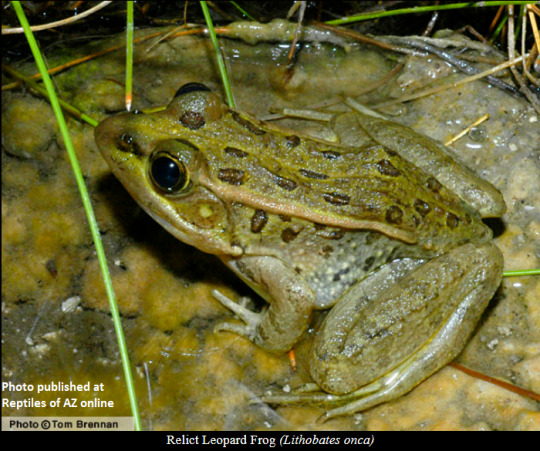
It’s distribution range:
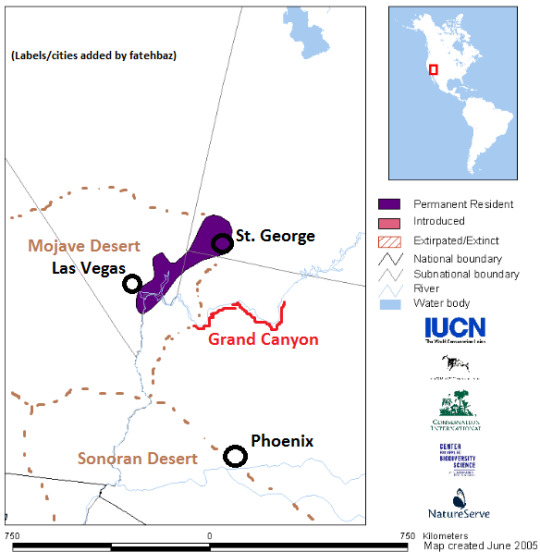
Here’s a closer look at the distribution range and its proximity to Las Vegas:
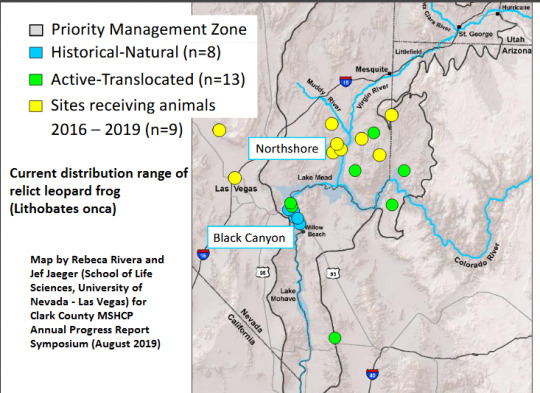
Here’s a look the frog’s habitat:


-----
A 4th species of leopard frog with a small distribution range endemic to the deserts of the Southwest used to be recognized. It was called the “Vegas Valley leopard frog” (Lithobates fisheri) and was thought to have been endemic to the Las Vegas area, and was thought to have gone extinct sometime around the mid-1940s due to the urban development of Las Vegas. But in 2011, newly-reported research showed that the species was actually a population of the Chiricahua leopard frog. (Which is still intriguing, because the closest known populations of Chiricahua leopard frogs live near Phoenix, so the population at Las Vegas was isolated.)
-----
Also in this region, there’s also an introduced population of Rio Grande leopard frogs (Lithobates berlandieri) which now lives in the lower Colorado River area near Yuma and Imperial (California), functionally within the Sonoran Desert ecoregion. The Rio Grande leopard frog is not endemic to the deserts. Though there are native populations of the species in the Chihuahuan Desert, the frog has a much wider distribution; it’s kind of like a subtropical frog mostly associated with Mexico and Central America. Here’s it’s distribution range:

-----
There are some northern leopard frogs living in the area along the northern edge of the Mojave and also in the mountains of northern Arizona and New Mexico. And these northern leopard frogs - though not endemic to the region - are also in danger of localized extinction.
Northern leopard frogs (Lithobates pipiens), which are widely distributed across much of the northern Great Plains, Midwest, and Canada, are famous because they were the ubiqituous “laboratory frog” used in dissection lessons in school classrooms for decades. The northern leopard frog is, itself, critically endangered in its small, isolated, and intermittent populations in dryland environments west of the Continental Divide.
Here’s a map from the Canadian federal government (COSEWIC, after Stebbins 2003 and Smith and Keinath 2007) showing how the northern leopard frog has experienced local extinction in much of the drylands of the inland West:

[The lighter shade of pink/red in the inland west and Pacific Northwest depicts where northern leopard frogs have gone extinct in recent decades, probably due to a combination of chrytid fungus, climate change, and human development of agricultural and riparian landscapes.]
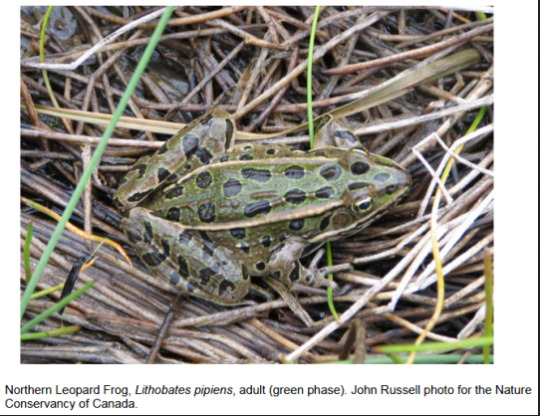
-----
Feel bad for these creatures.
15 notes
·
View notes
Link
Excerpt from this story from Silver City Daily Press:
The Center for Biological Diversity, the U.S. Forest Service and the U.S. Fish and Wildlife Service reached an agreement this month to protect rivers and streams in eastern Arizona and western New Mexico from cattle grazing.
The Center for Biological Diversity, which has conducted forestwide surveys of grazing allotments over the past four years, sued the agencies in January 2020, claiming and offering evidence that cattle were not being kept off riparian habitats, which was endangering rare plants and animals and constituted a violation of both the federal Endangered Species Act and a decades-old settlement.
In the 1998 legal settlement, the Forest Service agreed to prohibit domestic livestock grazing from these and other streamside habitats while it conducted a consultation with the Fish and Wildlife Service on the impacts grazing has on threatened and endangered species.
By the time the Center for Biological Diversity sued again over the issue, ranchers and environmentalists agreed that fences just weren’t being kept up. But some ranchers perceive the Forest Service’s relatively new requirement that they keep their cattle off rivers as government overreach and an unfair taking. After all, cattle growers didn’t have to keep their stock off rivers — a critical source of water — in the days of yore.
“There’s already been a right to use the river that has been there with the allotment, and they take someone’s right away. It should be illegal to shut you off the river, that’s the truth of the matter,” Joe Nelson, a Catron County rancher with a grazing allotment in the Glenwood Ranger District, told the Daily Press in March of last year. “You’re supposed to be paid for what they take away, and the allotments have [just] been reduced.”
But the waterways are home to numerous federally listed endangered and threatened species, including southwestern willow flycatchers, yellow-billed cuckoos, Gila chub, loach minnow and spikedace fish, Chiricahua leopard frogs and narrow-headed and northern Mexican garter snakes.
3 notes
·
View notes
Photo

Pond dweller by Photosuze Chiricahua Leopard Frog https://flic.kr/p/2i1ijiC
0 notes
Text
Rare leopard frog found beyond its known range in Southwest
Rare leopard frog found beyond its known range in Southwest
[ad_1]
A rare frog has been found beyond its known range in the U.S. Southwest
July 24, 2020, 4:07 AM
2 min read
Share to FacebookShare to TwitterEmail this article
FLAGSTAFF, Ariz. —
A rare frog has been been found beyond its known range in the Southwest.
A U.S. Forest Service volunteer recently photographed a Chiricahua leopard frog in an earthen stock tank near the town of Camp…
View On WordPress
#Amphibians#Animal health#Animals#Arizona#Biology#Environment#Environment and nature#Forests#Frogs#General news#Government and politics#health#Mountain lions#North America#Science#United states#Wildlife#Wildlife health#Zoology
0 notes
Text
Chiricahua Leopard Frog
Did you know that frogs have nictitating membranes?
Originally posted at stories.starmind.org.
0 notes